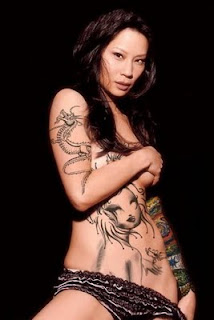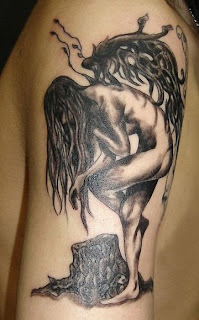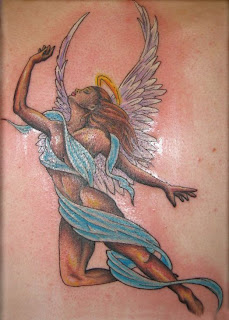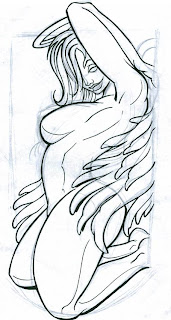The Girl with the Dragon Tattoo (original title in Swedish: Män som hatar kvinnor – "Men Who Hate Women") is an award-winning crime novel by Swedish author and journalist Stieg Larsson, the first in his "Millennium series".
At his death in November 2004, Larsson left three unpublished novels that made up the trilogy. It became a posthumous best-seller in several European countries as well as in the United States. Larsson witnessed the gang rape of a young girl when he was 15. He never forgave himself for failing to help the girl, whose name was Lisbeth – like the young heroine of his books, herself a rape victim, which inspired the theme of sexual violence against women in his books.
This novel supplies a genealogical table to understand the relationships of the five generation-old Vanger family who, in the novel, are under investigation. Robert Dessaix of the Sydney Morning Herald writes:
An epic tale of serial murder and corporate trickery spanning several continents, the novel takes place in complicated international financial fraud and the buried evil past of a wealthy Swedish industrial family. Through its main character, it also references classic forebears of the crime thriller genre while its style mixes aspects of the sub-genres. There are references to Astrid Lindgren, Enid Blyton, Agatha Christie and Dorothy L. Sayers, as well as Sue Grafton, J.R.R. Tolkien, Val McDermid, Elizabeth George, Sara Paretsky, and several other key authors of detective novels. A journalist and magazine editor in Stockholm until his death, Larsson reveals a knowledge and enjoyment of both English and American crime fiction. He declared that he wrote his opus for his own pleasure in the evenings after work.


With the exception of the fictional Hedestad, the novel takes place in real Swedish towns. The Millennium magazine featured in the books has characteristics similar to that of Larsson's magazine, Expo, which also had financial difficulties.
Mikael Blomkvist, who publishes the political magazine Millennium in Stockholm, has lost a libel case involving damaging allegations about billionaire Swedish industrialist Hans-Erik Wennerström, and is sentenced to three months in prison. Blomkvist steps down from his position on the magazine's board of directors. At the same time, he is offered an unlikely freelance assignment by Henrik Vanger, the elderly former CEO of Vanger Enterprises which he accepts — unaware that Vanger has already commissioned a comprehensive investigation into Blomkvist's personal and professional history carried out by gifted private investigator Lisbeth Salander. In her book "There Are Things I Want You to Know" About Stieg Larsson and Me, Eva Gabrielsson writes, "In the first volume of the trilogy, Henrik Vanger speaks for Stieg when he tells Mikael Blomkvist, 'I've had many enemies over the years. If there's one thing I've learned, it's never get in a fight you're sure to lose. On the other hand, never let anyone who has insulted you get away with it. Bide your time and strike back when you're in a position of strength-- even if you no longer need to strike back.'" Stieg Larsson was a strong believer in a code of ethics and he shows this through characters such as Henrik Vanger and Anders Jonasson.















Blomkvist visits Vanger at his estate on the tiny island of Hedeby. The old man draws Blomkvist in by promising not only financial reward for the assignment, but also solid evidence against Wennerström. Blomkvist agrees to spend a year writing the Vanger family history as a cover for the real assignment: solving the "cold case" of the disappearance of Vanger's niece Harriet some 40 years earlier. Vanger admits he is obsessed with finding out the truth of what happened to Harriet, and expresses his suspicion that Harriet was murdered by a member of the vast Vanger family, many of whom were present in Hedeby on the day of her disappearance. Each year on his birthday Harriet gave Henrik a pressed flower. Vanger explains that every year since Harriet's disappearance, the murderer has sent him the mocking birthday gift of a framed pressed flower (often of a rare variety), each postmarked from various different countries.
Blomkvist uproots himself from his life in Stockholm, moving to Hedeby and becomes acquainted with the members of the extended Vanger family, most of whom resent his presence. He does, however, start a short lived affair with Cecilia Vanger, the niece of Henrik who has been separated from her abusive husband for many years (she is separated but not divorced, as those in the Vanger family rarely get divorced).
Meanwhile, Salander meets her newly assigned legal guardian, Nils Bjurman. Nils Bjurman is a secret sadist who uses his position to extort sexual favors from her in return for allowing her access to the money from her own financial accounts. After two sexual assaults, Salander attacks Bjurman with a taser, sexually assaults him, and forcefully tattoos him, threatening release of a video of him raping her in return for full control of her bank accounts.
Blomkvist fulfills his contractual obligations by immersing himself in the case. He discovers that he has been investigated by Salander (on behalf of Henrik Vanger) and he realises that she has hacked into his computer. Recognising her talents, he persuades her to assist him with research. Together, they discover entries in Harriet's diary that list the names of missing women from across Sweden; this leads them to suspect that they are on the trail of a serial killer who possibly has an accomplice and has been at large for decades. The names are each attached to Bible verses describing brutal forms of divine retribution. Blomkvist and Salander eventually become lovers.
The two discover that Harriet's brother Martin, now CEO of Vanger Industries, is the serial killer who has been raping and murdering hundreds of women for years, having been "initiated" into serial murder by his late father, Gottfried. Salander saves Blomkvist's life when Martin attempts to kill him, and shortly after Martin is killed in a car accident attempting to escape Salander.
Blomkvist realizes that Martin did not know what had happened to Harriet and therefore, Harriet must still be alive. He tracks her down and persuades her to return to Sweden. Blomkvist reluctantly agrees with Harriet and Henrik that he will not publish any of the evidence he has found on the Vanger family in a journalistic capacity. He is persuaded to keep the family's dark secrets to himself, but only on the condition that the family make considerable annual donations to charities which support victims of domestic violence.
Vanger's promises of evidence regarding Wennerström prove to have been mostly a lure for Blomkvist and are not especially substantial. However, using her investigative skills, Salander breaks into Wennerström's computer and discovers that his crimes go beyond even what Blomkvist was convicted of libel for printing. Using the evidence she found, Blomkvist prints an exposé article and book which destroys Wennerström, who is later found dead under suspicious circumstances. The exposé catapults Blomkvist and Millennium to national prominence. Salander almost pursues a relationship with Blomkvist, but is disheartened after seeing him and colleague Erika Berger together and walks away.
Mikael Blomkvist, journalist, publisher of Millennium magazine, and amateur sleuth. Early in his career, he was compared to Astrid Lindgren's fictional boy detective Kalle Blomkvist (in the English translation, Bill Bergson), and the nickname stuck.
Lisbeth Salander, antisocial but extremely intelligent hacker and researcher, specialising in investigating people. She has a photographic memory, and is believed by Blomkvist to have Asperger syndrome. She has been compared to Pippi Longstocking,[5] and a colleague has stated that Larsson conceived Salander partly as a "grown up Pippi Longstocking". Henrik Vanger, retired industrialist and former CEO of Vanger Corporation.
Martin Vanger, brother of Harriet and CEO of the Vanger Corporation.
Cecilia Vanger, daughter of Harald Vanger, and one of Henrik's nieces.
Hans-Erik Wennerström, corrupt Swedish industrialist and Blomkvist's nemesis.
Harriet Vanger, Henrik's great-niece (usually referred to as his niece) and Gottfried's daughter who vanished 40 years ago. Holger Palmgren, lawyer, and earlier guardian of Lisbeth Salander.
Nils Bjurman, corrupt lawyer and guardian of Lisbeth Salander after taking over from Palmgren.
Anita Vanger, Cecilia's sister.
Birger Vanger, Anita and Cecilia's brother.
Erika Berger, editor of Millennium, friend and on-and-off lover of Blomkvist's.
Dirch Frode, lawyer for Vanger Corporation, and main friend and assistant to Henrik Vanger.
Dragan Armansky, director of Milton Security, Salander's boss and quasi-father figure.
Christer Malm, Art director and designer of Millennium. Also part owner of the magazine together with Berger and Blomkvist. Gustaf Morell, Retired Detective superintendent (inspector while investigating Harriet’s disappearance). Isabella Vanger, Harriet and Martin Vanger's mother and wife of the late Gottfried Vanger.
Gottfried Vanger, (deceased) father of Harriet and Martin. An abusive alcoholic with neo-Nazi sympathies. Jan Köbin, with whom Mikael Blomkvist entrusts the printing of his book on the Wennerström affair as well as other special printings throughout the whole series. In Stieg Larsson's real life, he was the owner of Hallvigs Reklam AB in Morgongåva. Köbin used his own car to deliver copies of Expo, the magazine cofounded by Larsson and Eva Gabrielsson, on time. In her book "There Are Things I Want You to Know" About Stieg Larsson and Me, Gabrielsson describes the resistance that Expo faced in Sweden, and Larsson's inclusion of Köbin in his novels as him "pa[ying] homage... to an 'ordinary hero'..."
Major themes
Larsson makes several literary references to the genre's classic forerunners, and comments on contemporary Swedish society. Reviewer Dessaix writes that "His favourite targets are violence against women, the incompetence and cowardice of investigative journalists, the moral bankruptcy of big capital and the virulent strain of Nazism still festering away" in Swedish society.
Larsson further enters the debate as to how responsible criminals are for their crimes and how much is blamed on upbringing or society. Salander has a strong will and assumes that everyone else does, too. She is portrayed as having suffered every kind of abuse in her young life, including an unjustly ordered commitment to a psychiatric clinic and subsequent instances of sexual assault suffered at the hands of her court-appointed guardian. Since she holds others responsible for their actions, she takes revenge on those who abuse others.
Reception and awards
A tale of contemporary culture and corruption, the novel was released to great acclaim in Sweden and later, on its publication in many other European countries. In the original language, it won Sweden's Glass Key Award in 2006 for best crime novel of the year. It also won the 2008 Boeke Prize, and in 2009 the Galaxy British Book Awards for Books Direct Crime Thriller of the Year, and the prestigious Anthony Award for Best First Novel.
Larsson was posthumously awarded the ITV3 Crime Thriller Award for International Author of the Year in 2008.
As of June 3rd, 2011, The Girl with the Dragon Tattoo has sold over 3.4 million copies in hardcover or ebook formats, and 15 million copies altogether.
Film adaptations
The Swedish film production company Yellow Bird created film versions of the Millennium Trilogy – The Girl with the Dragon Tattoo (Swedish title: Män som hatar kvinnor, "Men Who Hate Women"), The Girl Who Played with Fire (Swedish title: Flickan som lekte med elden, "The Girl Who Played with Fire") and The Girl Who Kicked the Hornets' Nest (Swedish title: Luftslottet som sprängdes, "The Air Castle that was Blown Up"). The films are co-produced with Nordisk Film and TV company, with Danish filmmaker Niels Arden Oplev directing the 1st and Daniel Alfredson directing the 2nd & 3rd.
Filming began in early 2008, and The Girl with the Dragon Tattoo opened in Sweden, Denmark, Norway, Finland and Iceland in February–March 2009. In Norway and Denmark, it is the most viewed Swedish film ever, and in Sweden total admissions are above one million.
The films have been sold to Sweden, Denmark, Norway, Finland, Iceland, the United Kingdom, Germany, France, Italy, Greece,Spain,Portugal, Belgium, the Netherlands, Australia, New Zealand, Switzerland, Luxembourg, Poland, Turkey, Mexico and the United States.
The film was acquired for theatrical and home video release by arthouse distributor Music Box Films. It had its American premiere on March 6, 2010 at the Miami Film Festival titled The Girl with the Dragon Tattoo. The film opened in US theaters in limited release on March 19, 2010.
Played with Fire and Hornets' Nest were released in the United States in 2010 by Music Box Films. Men Who Hate Women opened in France on 13 May, and in Italy and Spain on 29 May 2009.
Played with Fire opened simultaneously in Sweden, Norway, and Denmark on 18 September 2009.
Hornet's Nest was released 27 November 2009 in Sweden, Norway, Iceland, Denmark and Finland in January 2010.
In the UK, The Girl With the Dragon Tattoo opened to critical acclaim in March 2010 and made more than £2 million at the box office. Sales of the DVD on its 19 July release have made it the highest selling foreign language title of the year in the UK. The Girl Who Played with Fire was released in cinemas the UK on 27 August and the final installment, The Girl Who Kicked the Hornets' Nest is set for release on 26 November.
Producer Søren Stærmose of Yellow Bird, who holds the screen rights to the books, has been approached by directors including Ridley Scott, and Martin Scorsese.
On December 16, 2009, leading Swedish newspaper Svenska Dagbladet reported that Sony Pictures Entertainment are in final negotiations with Yellow Bird about the film rights according to Yellow Bird Managing Director Mikael Wallén. Steve Zaillian has been in discussions to adapt the first book.
In 2010, David Fincher was set to direct a Hollywood adaptation of the book, for release in December 2011. According to The Guardian, George Clooney, Johnny Depp, and Brad Pitt were all interested in playing the central role of Mikael Blomkvist, but Daniel Craig was officially confirmed as the lead in July. On August 16, 2010, it was officially confirmed that Rooney Mara will play Lisbeth Salander. Robin Wright is currently in talks to play Erika Berger, while Christopher Plummer and Stellan Skarsgård are attached to play Henrik and Martin Vanger. Trent Reznor also recently announced that he would be joining Fincher once again and creating the soundtrack.

















































